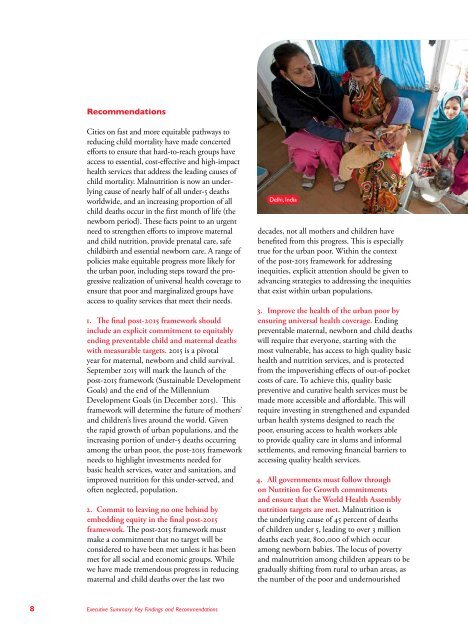sowm_2015__int__africa_full_report_low_res
sowm_2015__int__africa_full_report_low_res
sowm_2015__int__africa_full_report_low_res
Create successful ePaper yourself
Turn your PDF publications into a flip-book with our unique Google optimized e-Paper software.
Recommendations<br />
Cities on fast and more equitable pathways to<br />
reducing child mortality have made concerted<br />
efforts to ensure that hard-to-reach groups have<br />
access to essential, cost-effective and high-impact<br />
health services that add<strong>res</strong>s the leading causes of<br />
child mortality. Malnutrition is now an underlying<br />
cause of nearly half of all under-5 deaths<br />
worldwide, and an increasing proportion of all<br />
child deaths occur in the first month of life (the<br />
newborn period). These facts po<strong>int</strong> to an urgent<br />
need to strengthen efforts to improve maternal<br />
and child nutrition, provide prenatal care, safe<br />
childbirth and essential newborn care. A range of<br />
policies make equitable prog<strong>res</strong>s more likely for<br />
the urban poor, including steps toward the prog<strong>res</strong>sive<br />
realization of universal health coverage to<br />
ensure that poor and marginalized groups have<br />
access to quality services that meet their needs.<br />
1. The final post-<strong>2015</strong> framework should<br />
include an explicit commitment to equitably<br />
ending preventable child and maternal deaths<br />
with measurable targets. <strong>2015</strong> is a pivotal<br />
year for maternal, newborn and child survival.<br />
September <strong>2015</strong> will mark the launch of the<br />
post-<strong>2015</strong> framework (Sustainable Development<br />
Goals) and the end of the Millennium<br />
Development Goals (in December <strong>2015</strong>). This<br />
framework will determine the future of mothers’<br />
and children’s lives around the world. Given<br />
the rapid growth of urban populations, and the<br />
increasing portion of under-5 deaths occurring<br />
among the urban poor, the post-<strong>2015</strong> framework<br />
needs to highlight investments needed for<br />
basic health services, water and sanitation, and<br />
improved nutrition for this under-served, and<br />
often neglected, population.<br />
2. Commit to leaving no one behind by<br />
embedding equity in the final post-<strong>2015</strong><br />
framework. The post-<strong>2015</strong> framework must<br />
make a commitment that no target will be<br />
considered to have been met unless it has been<br />
met for all social and economic groups. While<br />
we have made tremendous prog<strong>res</strong>s in reducing<br />
maternal and child deaths over the last two<br />
Delhi, India<br />
decades, not all mothers and children have<br />
benefited from this prog<strong>res</strong>s. This is especially<br />
true for the urban poor. Within the context<br />
of the post-<strong>2015</strong> framework for add<strong>res</strong>sing<br />
inequities, explicit attention should be given to<br />
advancing strategies to add<strong>res</strong>sing the inequities<br />
that exist within urban populations.<br />
3. Improve the health of the urban poor by<br />
ensuring universal health coverage. Ending<br />
preventable maternal, newborn and child deaths<br />
will require that everyone, starting with the<br />
most vulnerable, has access to high quality basic<br />
health and nutrition services, and is protected<br />
from the impoverishing effects of out-of-pocket<br />
costs of care. To achieve this, quality basic<br />
preventive and curative health services must be<br />
made more accessible and affordable. This will<br />
require investing in strengthened and expanded<br />
urban health systems designed to reach the<br />
poor, ensuring access to health workers able<br />
to provide quality care in slums and informal<br />
settlements, and removing financial barriers to<br />
accessing quality health services.<br />
4. All governments must fol<strong>low</strong> through<br />
on Nutrition for Growth commitments<br />
and ensure that the World Health Assembly<br />
nutrition targets are met. Malnutrition is<br />
the underlying cause of 45 percent of deaths<br />
of children under 5, leading to over 3 million<br />
deaths each year, 800,000 of which occur<br />
among newborn babies. The locus of poverty<br />
and malnutrition among children appears to be<br />
gradually shifting from rural to urban areas, as<br />
the number of the poor and undernourished<br />
8 Executive Summary: Key Findings and Recommendations




